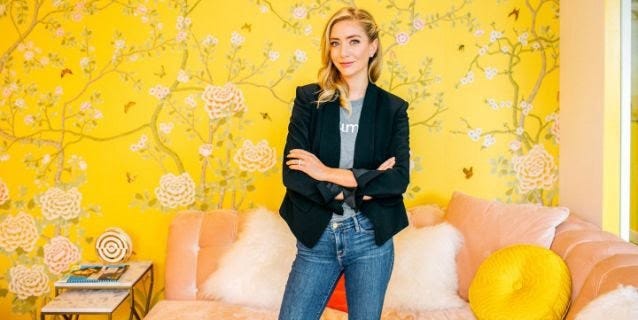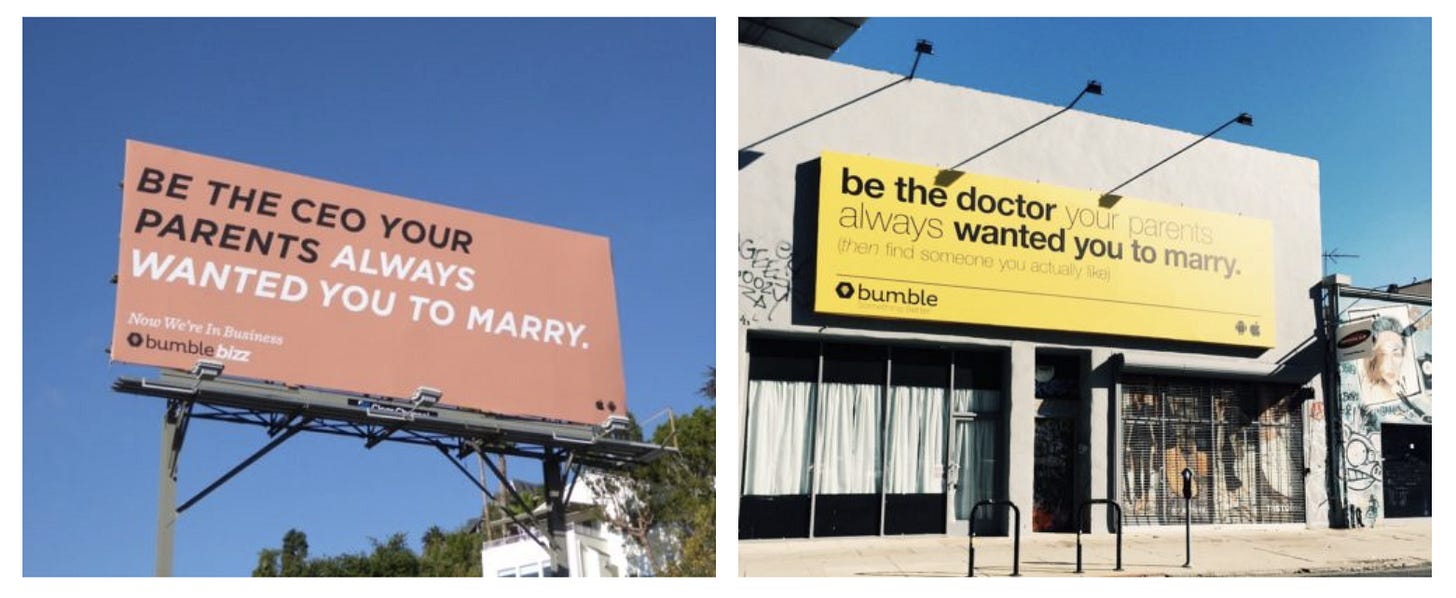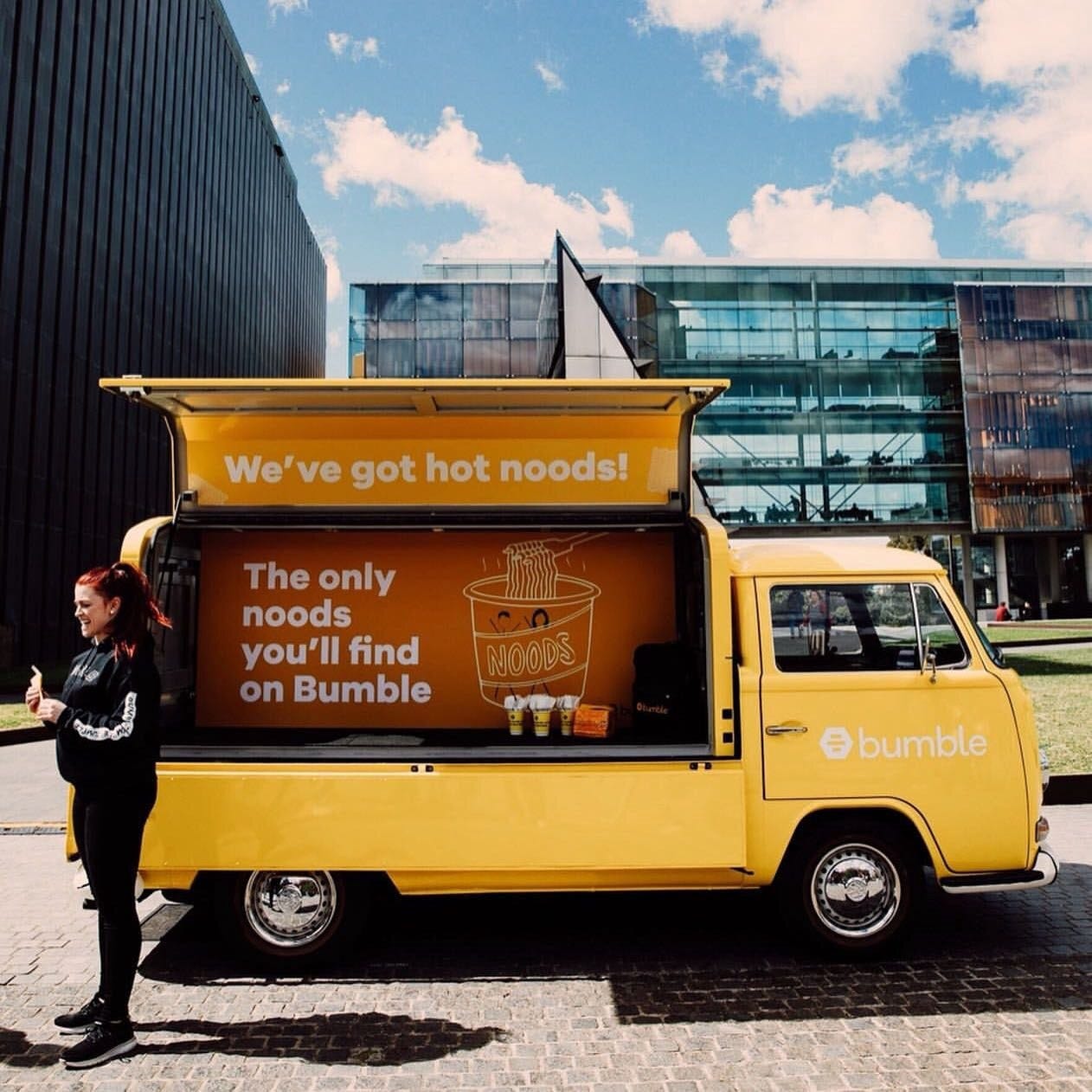Swiping right on Bumble's marketing.
Brandish Issue No.07. Your monthly newsletter on brand and cultural moments.
Hey fam, welcome back to brandish. If you’re enjoying this newsletter, please give it a like above💖 ^^
This month, we’re talking about the queen bee of online dating: Bumble 🐝
Brand Breakdown: Bumble ✨
How dating app, Bumble, generated buzz and established a beloved brand.
If you’ve been in the dating scene recently, I’d be willing to bet that you’ve heard of Bumble. Founded in 2014, Bumble began as the challenger brand of dating apps. Where most apps let anyone start the conversation, Bumble positioned themselves as the dating app for women (single or taken) and only let women send the first message. Currently, Bumble is one of the most popular apps in the app store with over 12M monthly active users and has expanded past dating into friendships with Bumble BFF and networking with Bumble Bizz.
I spent some time researching Bumble expecting to find the stereotypical dating-app-marketing story: a hot new dating app promising to match you with “hot singles in your area” gets all their downloads through aggressive paid ad campaigns. But that’s actually far from what I found. The more I dug into Bumble the clearer it became that although they spend money on ads, that’s not where their users come from. Even more interesting, nowhere in their ads do they even hint at the prospect of finding you a hot new boo…
But before I tell you how they get their users, let me tell you about the ultimate breakup comeback story: This month Bumble went public making their founder, Whitney Wolfe, the youngest female self made billionaire. Prior to starting Bumble, Whitney had co-founded Tinder with her ex boyfriend and served as VP of Marketing. But, due to growing tensions with other Tinder executives (aka her ex), she left Tinder and soon after filed a sexual harassment lawsuit. Yet, despite the salty parting, Whitney got the ultimate revenge, six months later she launched Bumble and turned it into America’s fastest-growing dating-app company.
So how did she break through the crowded dating app world? One word: branding.
Know the user…
The dating industry is highly competitive. It’s easy to download new apps and there are many to pick from. So how do you get people to believe that your app is the one that will solve their romantic woes?
From the beginning, Bumble knew who they wanted using their app: empowered women that were tired of the misogyny they faced when dating… actually though, this is basically word for word on their S1 filing.
Unlike other dating apps, Bumble’s marketing only targets women. While it seems counterintuitive to only market to half of your customer base, Bumble knew something all NYC club owners know too well: focus on getting the women in, and the men will follow.
Having a hyper-defined user also makes it easier to know what matters to them, and by default, design marketing campaigns that resonate. Bumble’s mission is to give women more power in dating. Their slogan “Make the first move” clearly calls out their biggest product differentiator while encouraging women to own their dating experience.
With these two in place, Bumble was perfectly positioned to develop a winning brand.
Building a winning brand
But first, you need to catch people’s attention. When you think of your traditional dating ad, it usually includes the picture of an attractive young person. The goal of those ads is to make you believe that their dating app is filled with good looking people waiting to match with you.
But this is far from the strategy Bumble went out with…
Be the CEO your parents wanted you to marry
For starters, when you see a Bumble billboard, they never talk about the interesting people you might meet on their app. Instead, Bumble makes women the main characters of their campaigns. Their typical billboards take dating-relevant sayings women are used to hearing and putting a female empowerment spin on it.
These billboards are used as a tool to elevate women with slogans such as “Be the CEO Your Parents Wanted You to Marry” and “Believe Women” while also bringing advocacy for the brand. Even if you are in a relationship, there’s something about being a woman and seeing those ads that makes you say “hell yes!”
Sliding into your DMs…
Bumble’s Social shows us they clearly know who they are speaking to… and they are speaking to them about more than just dating. Their posts range from light and funny to deep and personal. One post may talk about the struggles of dating, the next about black history month, and the next include a meme around the pandemic. Their tone feels like that of an older sister that knows best, it’s relatable and trustworthy.
It is on Social where Bumble grows the majority of their community. Their main Instagram account has over 560k followers. But they also have additional accounts like the OverheardBumble account that focuses on the conversations that happen on the app with 360k+ followers, and regional instagram accounts used to engage with users in a specific location.
We’ve got hot noods!
Bumble has also invested heavily on experience and field marketing in an attempt to bring their brand to their audience. The experiences they design are usually around promoting key features or products and, in the typical Bumble style, they riff-off terms commonly used in dating. For instance, when Bumble was trying to bring attention to their strict user guidelines against nudity, they hired a noodles food truck and slapped the words “The only noods you’ll find on Bumble.” Similarly, when they announced their photo verification feature, they hired a fish & chips truck and wrote “ Great Catch. Catfish just got served.”
You’d probably think that these local activations wouldn’t be large enough to gather the attention of their many million users. But what many forget with experience marketing, is that what you’re really looking for are the ripples. This means the pictures of the event then get shared online or the press coverage that you get from that one event. If these offline events are different and splashy enough, they create meaningful online dialogs.
Find them on Bumble
Bumble occasionally will also go out with campaigns including real Bumble users. One of their most successful campaigns was “Find Them on Bumble” used to celebrate having 3M NYC users. Bumble published a magazine spread on some of the most inspiring people from NYC that you can find on Bumble.
Separately, Bumble often publishes out real user stories of how particularly cute and endearing couples have met on Bumble. These couples were usually all about to “give up on dating for good” until Bumble came along and introduced them to their Prince Charming.
These stories are used as a tool to communicate on a personal level with their users. At the same time, they work as testimonials that their app is successful at finding you a partner, they showcase a success case study, and they ultimately elevate their users and transform them into advocates for their brand.
Your ex is cancelled
Bumble is also known for partnering with brands that align with their values. At the beginning of the quarantine, Bumble partnered with Babe Wine to create a spoof moving company and help cover the moving costs for people stuck living with their ex during the pandemic. Their “services” included everything from “assembling complicated Swedish furniture while you drink” to tailoring Bumble profiles to get the winners back on the dating scene.
These partnerships place Bumble alongside some of today’s coolest brands while allowing them to create activations that are fun, creative, and have even greater reach.
My take?
It’s no doubt that users connect deeply with the Bumble brand making it a powerful marketing tool. While brand is a difficult thing to measure, Bumble has stated that their brand has generated “word of mouth virality and strong, efficient user acquisition.” Not to mention only 22% of new users came from performance marketing in 2019 and 21% in 2020. So what do we learn from Bumble?
1. Stop building for everyone: Bumble’s audience is just women. This one decision has helped their product teams build features that matters to their users and their marketing team create campaigns that resonate.
2. There’s value in connecting with your users in person: Field marketing oftentimes goes overlooked but if done correctly it can be an affordable way to engage your audience, build your brand, and potentially get press.
3. Brand marketing isn’t a sham: I feel inclined to call this out. Any operator can tell you that Brand marketing is both expensive and difficult to measure. Hence why it’s gotten the rep that it’s not worth the investment. Yet, a strong brand can be one of the most valuable assets a company could have.
That’s all for today. If you’re not already subscribed, you can do so below:
Until next month!
xx- Dani
PS: If you want to save this article for later, you can find it on Medium here.













